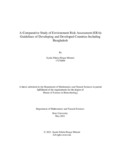A comparative study of Environment Risk Assessment (ERA) guidelines of developing and developed countries including Bangladesh

View/
Date
2021-05Publisher
Brac UniversityAuthor
Mimmi, Syeda Fahria HoqueMetadata
Show full item recordAbstract
Genetically Engineered (GE) plants are the demand of time for increased demand of food.
According to the report of International Service for the Acquisition of Agri-biotech Applications
(ISAAA), a total of 29 countries produce GE plants in 2019. A complete set of regulations need
to be followed from the development of a GE plant to its release into the environment. The
whole regulation system is categorized into separate stages for maintaining the proper biosafety.
Environmental Risk Assessment (ERA) is one of such crucial stage in the whole process. ERA
identifies potential risks and its impacts through science based evaluation process where it is
done in a case by case study. All the countries which deal with GE plants follow specific
guidelines to conduct a successful ERA. In this study, ERA guidelines of 4 developing and 4
developed countries including Bangladesh were compared. ERA guidelines of countries such as
India, Canada, Australia, the European Union, Argentina, Brazil and US were considered as
model to conduct the comparison study with Bangladesh. Initially, ten parameters were detected
to compare the required data and information among all the guidelines. Surprisingly, an adequate
amount of data and information requirements (e.g. If the intended modification/new traits of
interest has been achieved or not, Growth habit of GE plants, Consequences of any potential
gene flow upon the cultivation of GE plants to sexually compatible plant species, Potential
adverse effects on the human health etc.) matched between all the countries. However, a few
differences of data requirement (e.g. Agronomic conventions of non-transformed plants,
Applicants should clearly describe experimental procedures followed etc.) were also observed in
the study. Moreover, it was found that only a few countries provide instructions on the quality of
the data used for ERA. If these similarities are recognized in a more framed manner then the
approval pathway of GE plants can be shared.
